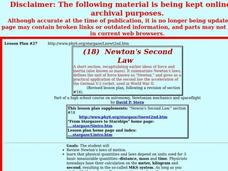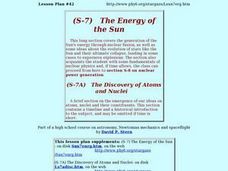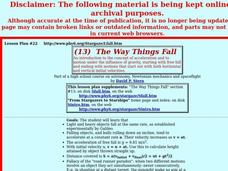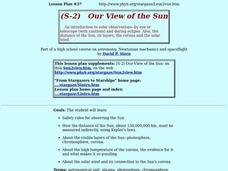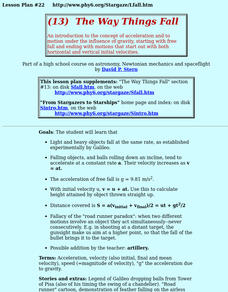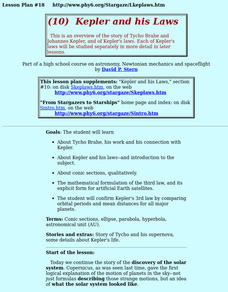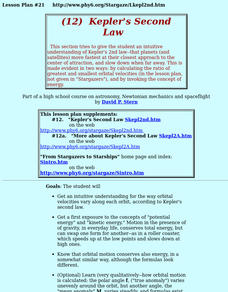Curated OER
Kepler's 3rd Law
Students derive the velocity in a circular orbit of any radius. They derive the Earth escape velocity and prove Kepler's 3rd law for circular orbits # A simple formula for the orbital period in a circular Earth orbit of given radius.
Curated OER
Newton's Second Law
Pupils examine how physical quantities and laws depend distance, mass and time. They examine the MKS system; meter, kilogram and second, for doing calculations.
Curated OER
The Discovery of the Solar System
Students study the ideas behind the heliocentric theory of Copernicus. They examine about retrograde motion of the planets as they move around the sun. They study astronomers who include Ptolemy, Copernicus, and Galileo.
Curated OER
The Energy of the Sun
High schoolers study energy generation by the Sun, which involves atoms and nuclei.
Curated OER
@23 Accelerated Frames of Reference: Inertial Forces #23a Frames of Reference: The Centrifugal Force
Students distinguish between the centripetal and centrifugal forces.
Curated OER
Momentum
Students learn the concepts of momentum and its conservation, using the recoil of a cannon as an example. They examine how momentum is a vector, allowing its conservation to be applied to problems in 2 and 3 dimensions.
Curated OER
Newton's Theory of Universal Gravitation
Young scholars explore how Newton tied together the gravity observed on Earth and the motion of the Moon. They apply an earlier lesson about centripetal forces.
Curated OER
The Discovery Of The Solar System
Students study the heliocentric theory of Copernicus, the ideas behind it and the explanations which it displaced. A discussion of retrograde motion of planets helps students explain the logic underlying the ideas of both Ptolemy and...
Curated OER
The Round Earth And Christopher Colombus
Students engage in a historical review, starting with the existence of the horizon at sea, proceeding to various studies of the Earth's size and shape, and leading to the attempt by Columbus to reach India by sailing westward.
Curated OER
Kepler and his Laws
Students examine Kepler's Laws. They confirm Kepler's 3rd law by comparing orbital periods and mean distances for all major planets and study conic sections, qualitatively.
Curated OER
The Way Things Fall
Students explore concept of acceleration and motion under the influence of gravity, starting with free fall and ending with motions that start out with both horizontal and vertical initial velocities.
Curated OER
Newton and his Laws
High schoolers explore Newton's laws, including what they state, and what the intuitive meaning is of the first and third laws.
Curated OER
Our View of the Sun
Students are introduced to safety rules for observing the Sun, how the distance of the Sun is measured using Kepler's Laws and identify the visible layers of the Sun. They discuss solar eclipses and view images of eclipses using the...
Curated OER
(S-4) The Many Colors of Sunlight
Learners observe and explore the characteristics of light.
Curated OER
(S-1B) Global Climate, Global Wind Flow
Students discuss how the horizontal transport of heat from equatorial regions polewards drives global wind systems.
Curated OER
(S-1A) Weather and the Atmosphere
Students discuss the way vertical convection transports heat from the surface upwards, and associated pressure and temperature profiles of the atmosphere.
Curated OER
The Way Things Fall
Pupils see that light and heavy objects fall at the same rate, as established experimentally by Galileo. They see that falling objects, and balls rolling down an incline, tend to accelerate at a constant rate a. Their velocity increases...
Curated OER
Kepler And His Laws
Students engage in an overview of the story of Tycho Brahe and Johannes Kepler, and of Kepler's laws. Each of Kepler's laws be studied separately in more detail in later lessons. They examine Kepler's 3rd law.
Curated OER
The Calendar
Learners engage in an overview of solar and lunar calendars, their history and lore. Also, of the day and the month, and their relations to the rotation period of the Earth and the orbital period of the Moon.
American Museum of Natural History
Planetary Mysteries
A website all about planetary mysteries—it's a one-stop-shop for all things, stars, planets, and space travel. Scholars read an astronomy overview to discover the page's big ideas, then choose from the plethora of resources, including...
Curated OER
Creative Writing - Research and Letters
Here's a fresh approach that combines research, business and personal letter writing, and creative story telling. Student groups research different decades in the life of a famous Japanese astronomer. They then craft a decade fact sheet,...
It's About Time
Our Community's Place Among the Stars
But isn't the Milky Way a candy bar? Lead a detailed discussion on the complex topic of our solar system and the Milky Way Galaxy as the class explores stellar evolution, structure, and investigates the relationship between luminosity...
Curated OER
#22 Frames of Reference: The Basics
Learners explore the concept of frames of reference in physics.
Curated OER
Kepler's Second Law
Students gain an understanding of Kepler's 2nd law--that planets (and satellites) move fastest at their closest approach to the center of attraction, and slow down when far away. They explore the concepts of "potential energy" and...



